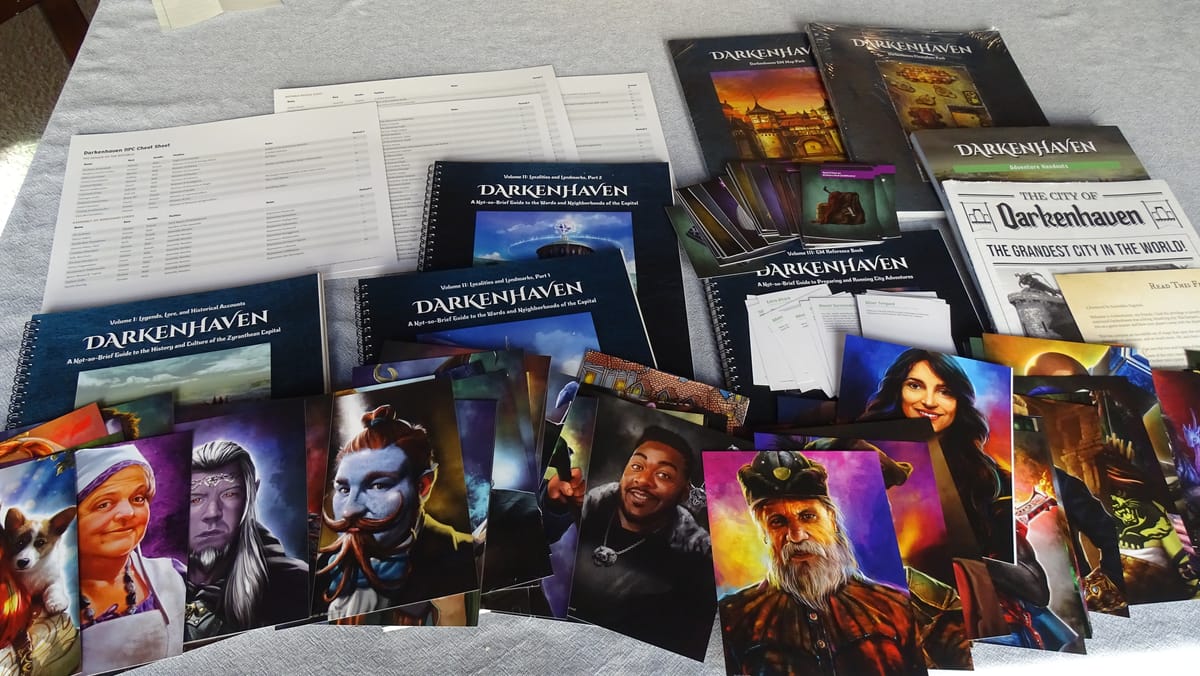
Box sets are hardly an unusual format for role playing games. It’s always been quite common for publishers to put out their various starter sets in a box, and that’s the most common use today. But a few decades back, boxes were also used for the other big stuff when a publisher had maps and cards and other things that just didn’t work as only a book. As a result, my shelves are lined with boxes for starter sets, campaign settings, megadungeons, and cities.
I’ve never seen a box set that compares to Darkenhaven.
Weighing in at over 11lbs, Darkenhaven is an already large box so stuffed with content that publisher Gooey Cube couldn’t fit it all inside. There’s literally more material shrink wrapped to the box. I’m going to cover everything in the set, but before we dive in, I want to paint a sort of picture of the overall product.
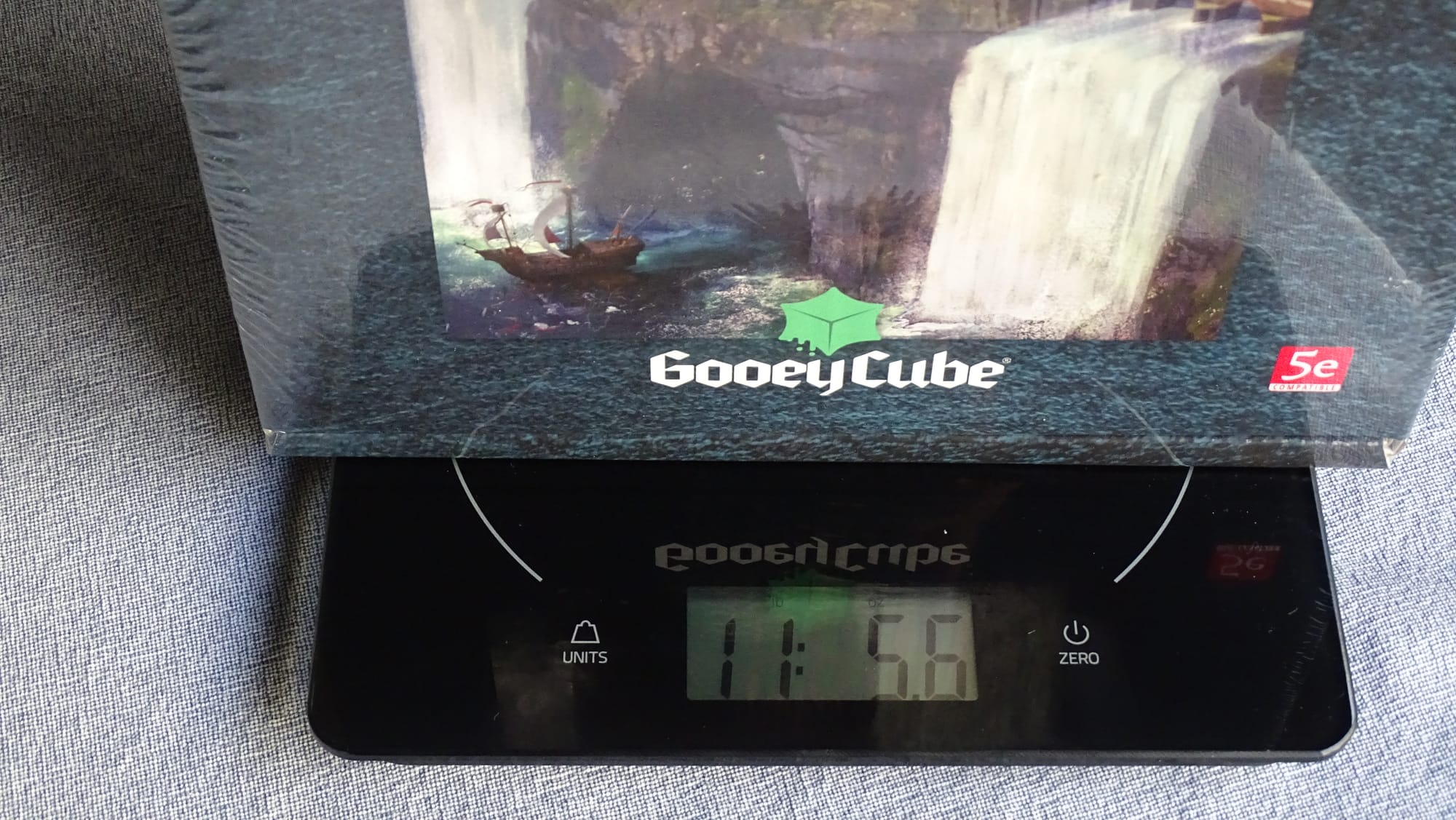
Firstly, Darkenhaven is the capital of the Zyranthean Republic in Gooey Cube’s campaign setting of Zyathé. It’s worth noting that Darkenhaven is the surface city, and its underground sea cave-based sister city of Gloomport will be detailed in its own box set. The world of Zyathé and the adventures set there are D&D 5th Edition/OGL compatible high fantasy, not too far removed from something like Forgotten Realms though wholly unique in the particulars. Secondly, this is my first Gooey Cube product, but it is quite obvious that they are big on visual presentation. Maps and art comprise a large portion of the material here, showing off various parts of the city and its peoples. It really can pull you into the setting in a way that descriptions just can’t.
So, with that in mind, let's start with visuals. The box comes with two full-color city maps, one done with six pieces of folded 17 x 22 inch poster pages, and the other made from 24 sheets in 8.5 x 11 inches. The two maps are the same print, but the poster map is intended for player use and doesn’t have things like street names or the building reference codes on them. The inside of the cover of the map pack is also a map of the city proper, only leaving off the eastern parts beyond the main city wall and making it perfect for quick reference. Fully laid out, either city map is epic in scale yet wonderfully detailed. It’s understandable why the “Read This First” paper makes the suggestion to check the map out before diving in.
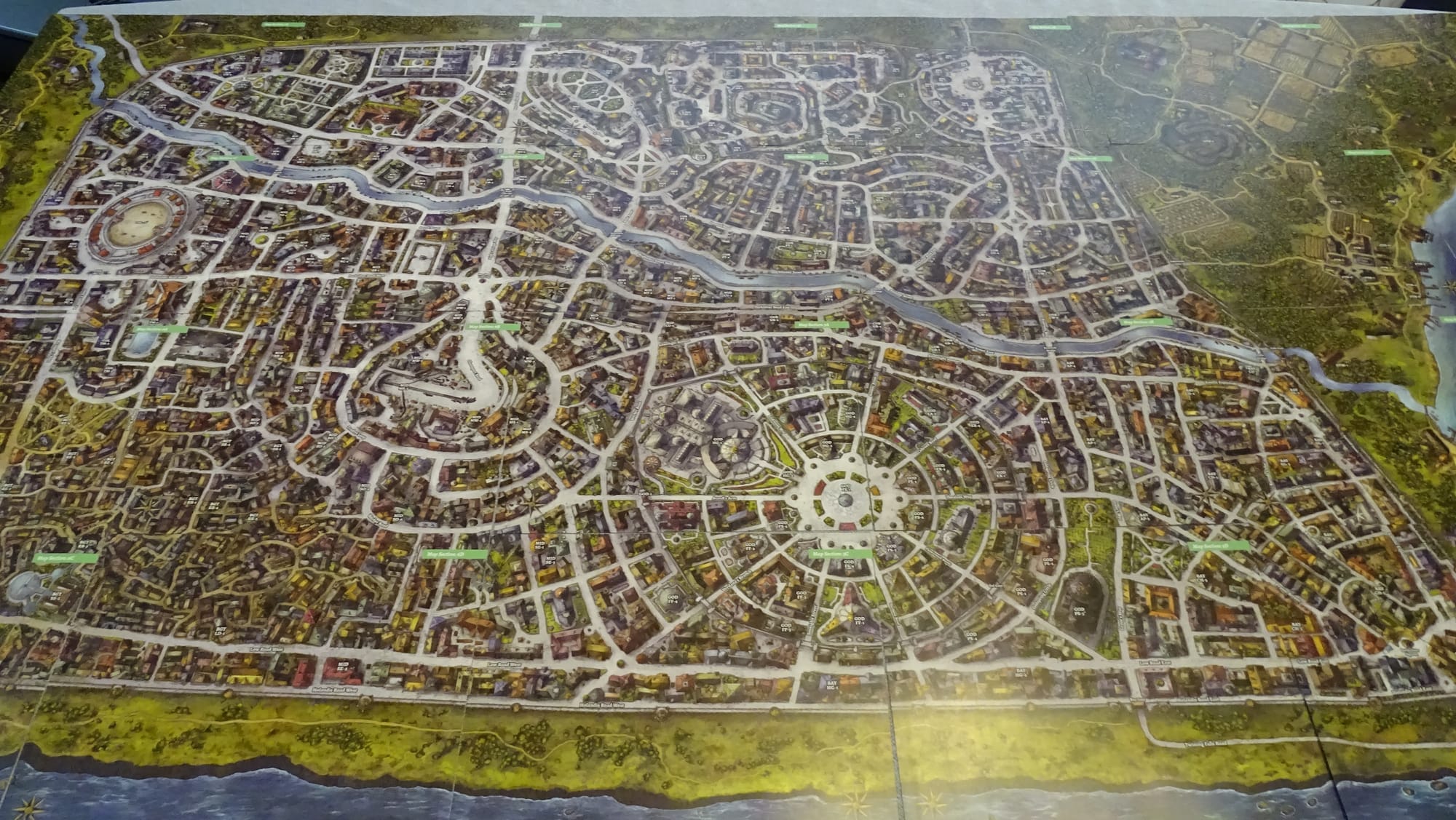
Moving on from the city maps, there are dozens of floorplan maps for locations scattered across the different districts. Taverns, temples, gardens, abandoned buildings, and a variety of shops are all covered in warmly rendered 8.5 x 11 sheets with black backgrounds. The floorplans are of specific locations detailed in Book 2 (more on that later), sometimes with multiple sheets to cover every floor of the building.
Continuing with the 8.5 x 11 art is the Adventure Handouts sheets. There are 59, full page art handouts of various spots around the city. Most are outdoor scenes of the buildings which also have the previously mentioned floorplans. These are usually done in bright or contrasting colors which makes the page “pop” in a way that draws you in. Most of the art has people somewhere in the page, which does a fantastic job of conveying the scale and grandeur of the city. Art is subjective and people all like different things, but in this kind of use case it’s hard not to be impressed. A picture really is worth a thousand words.
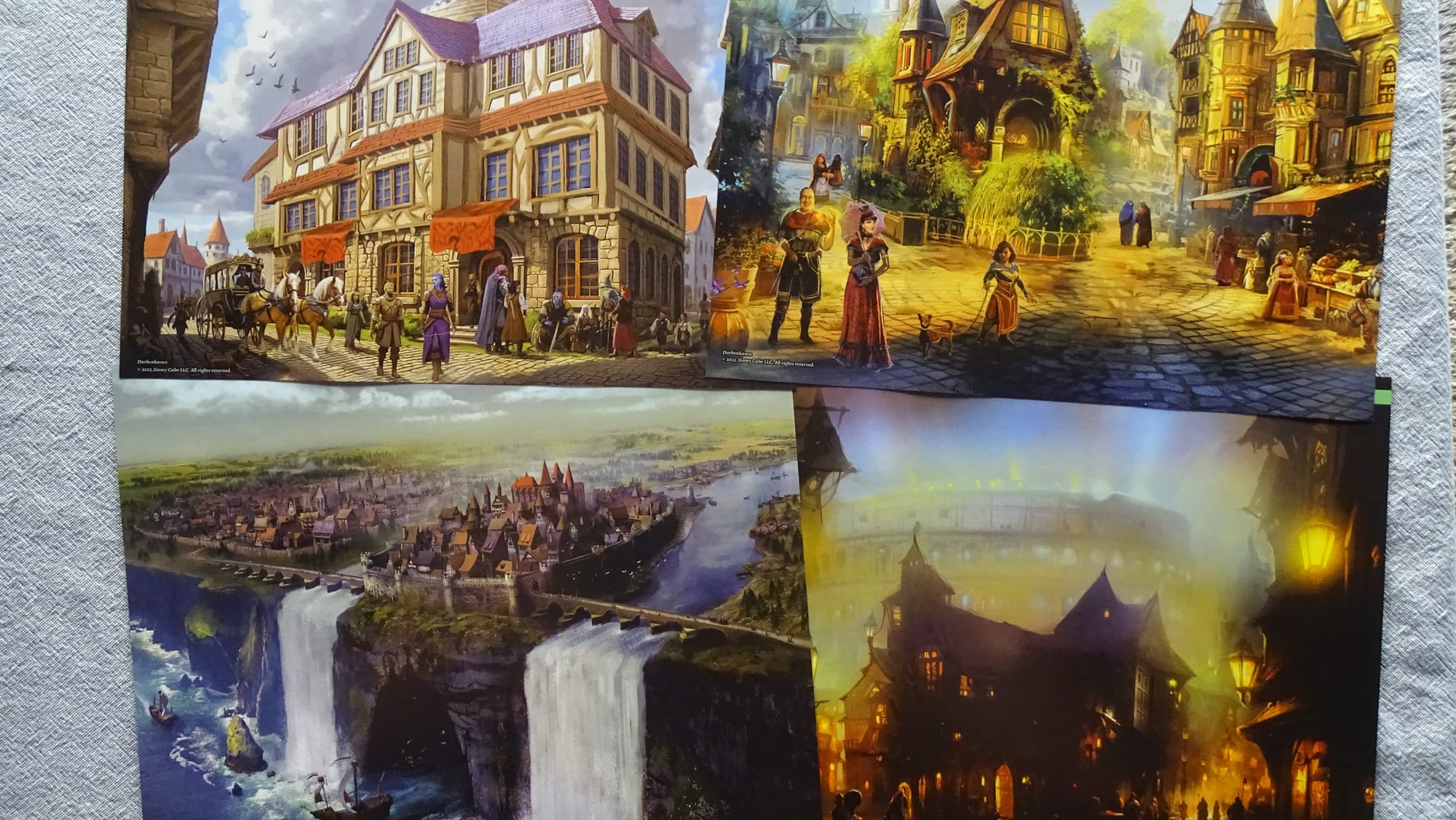
For the final bit of art, we come to the cards. The biggest ones are postcard sized headshots of over 100 Darkenhaven NPCs. While some are based on local VIPs, there’s just as many shop owners, innkeepers, and colorful people the players might meet on the streets. Many of these NPCs are seemingly based on real people, and so, while obviously stylized, the portraits are very detailed and well done. The back of each card gives the name and a summary of who they are and what they do. Finally, there are the special item cards. These are card game sized with a nice drawing of the item on the front and the item stats on the back, or the page number in the guides for those that are too complex to summarize. There are also the Gooey Rewards cards, which are part of the Gooey Cube house rules. These don’t have art but are the same size as the item cards.
The meatiest bit of the box set are the four 100+ page books of city information and GM guidance spread across three volumes. These are done with a ring-type binding and initially I was concerned about the durability of the books, but pages are thick and the binding is dense, which prevents the snagging and tearing issues I’ve seen with other spiral binds. I suspect a drop hard enough to damage these would probably damage most books. The binding also gives the books the ability to lay flat or be folded all the way around, handy for reading or presentation.
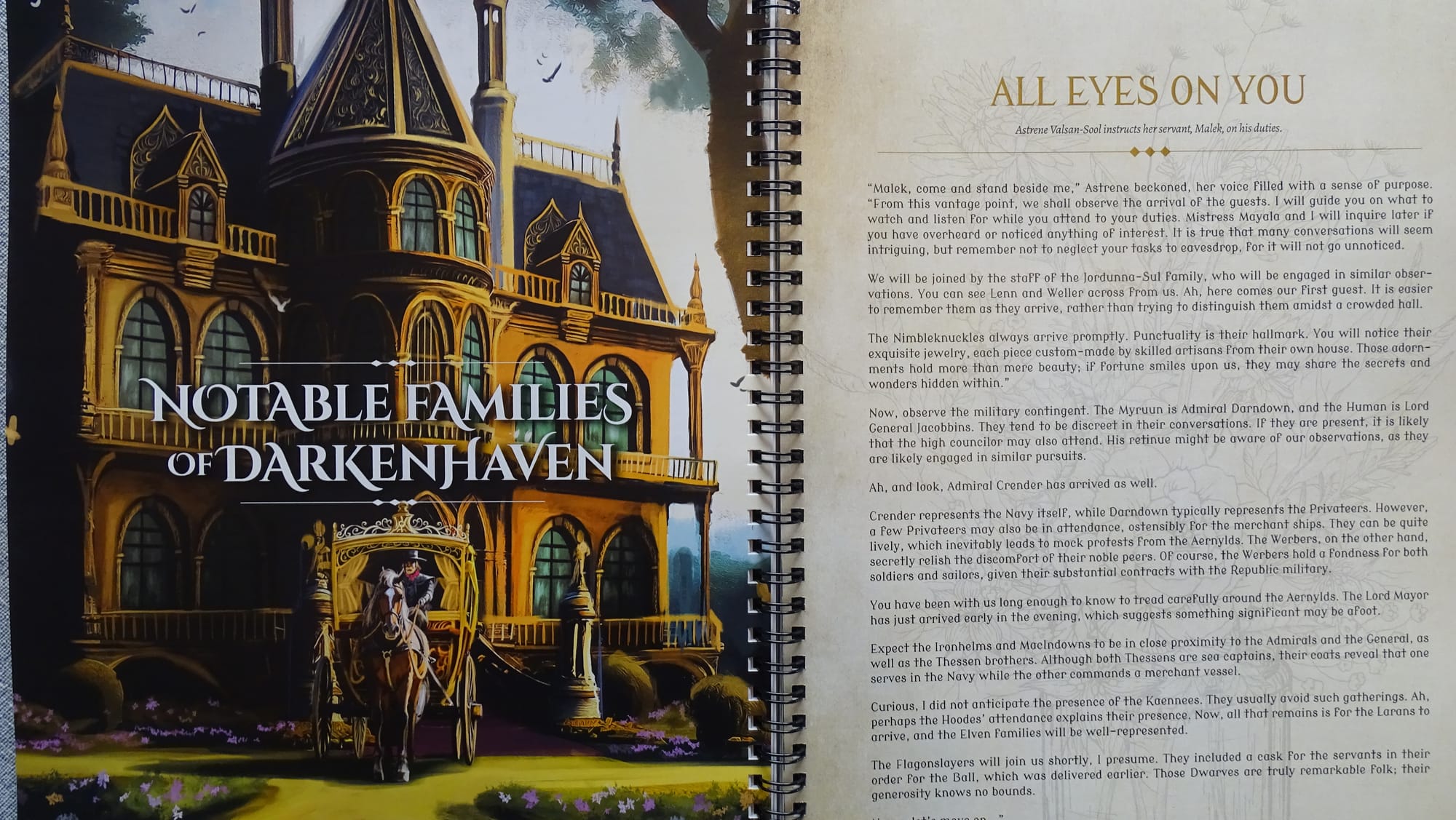
Each of the volumes has a different focus.
Volume 1 goes over the city’s history, politics, laws, institutions, and the various families and guilds who are major players in how the city is run. Since Darkenhaven is the capital, it has embassies, so some time is spent on the ambassadors, the countries they represent, and the surrounding lands. It also goes into the city’s defense and the militias of each ward. Altogether, it’s the biggest of the four books and loaded with information. If you read through the whole thing, you’ll probably know more about Darkenhaven than you do your own town.
Volume 2 goes over the various locations in the city, focusing on each ward, that ward’s neighborhoods, and shops and other points of interest in each. These tie back into the 8.5 x 11 city maps, which code back to this volume for information. These descriptions often include NPCs and buildings which are then referenced back to the portrait cards, floorplans, and Adventure Handout sheets. Essentially, you might go from a bird’s eye map view to a street view to a peek inside with a picture of the occupants, even before you get to any descriptive text of a particular place. Many of these descriptions leave fertile ground for potential adventure hooks.
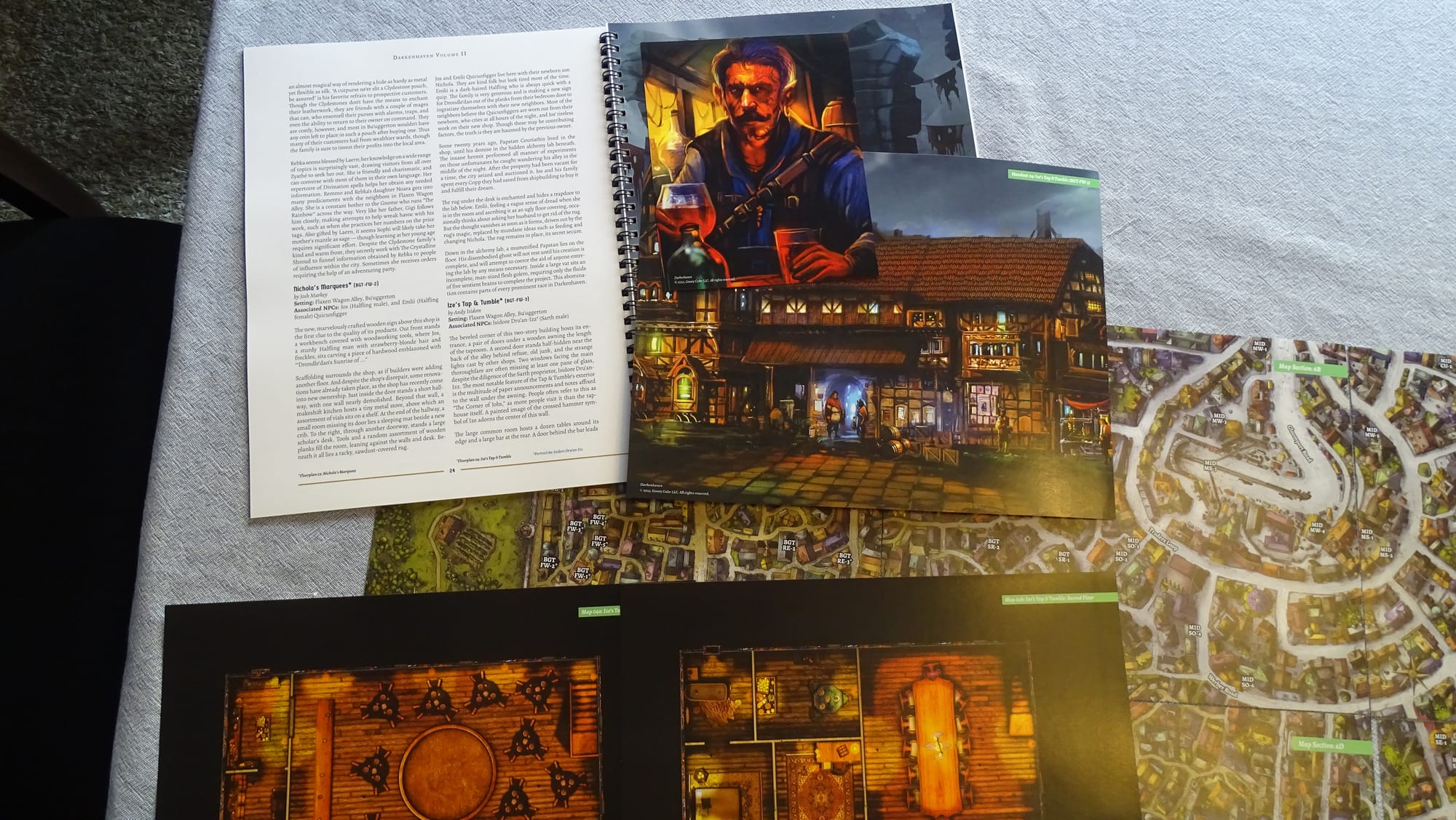
Volume 3 is about Gamemastering the city and it’s here that we find an aspect of Gooey Cube game design that I quickly came to love: the “Not-So-Random-Encounter”. Taking up about half this book, the NSREs are location based encounter ideas for a DM to throw at the party. Divided into non-lethal, potentially lethal, and lethal, some of these might be hooks, or just an event that happens, and some lead straight to combat. Many of them have some boxed text and point back to NPCs and locations that would be covered in Volume 2, or even have recommended rewards that show up as an item card. These aren’t fully fleshed out encounters, but more like a buffet of ideas to get the DM started on a larger adventure for that ward or neighborhood. As part of the NSRE system, some of these have a presence in the Battle Stats Table chapter. These go over a combat encounter with stat blocks, but since nothing is tied to character levels they have some very good suggestions on running these combats at different difficulties. These are so well done that my only complaint with them is how few there are.
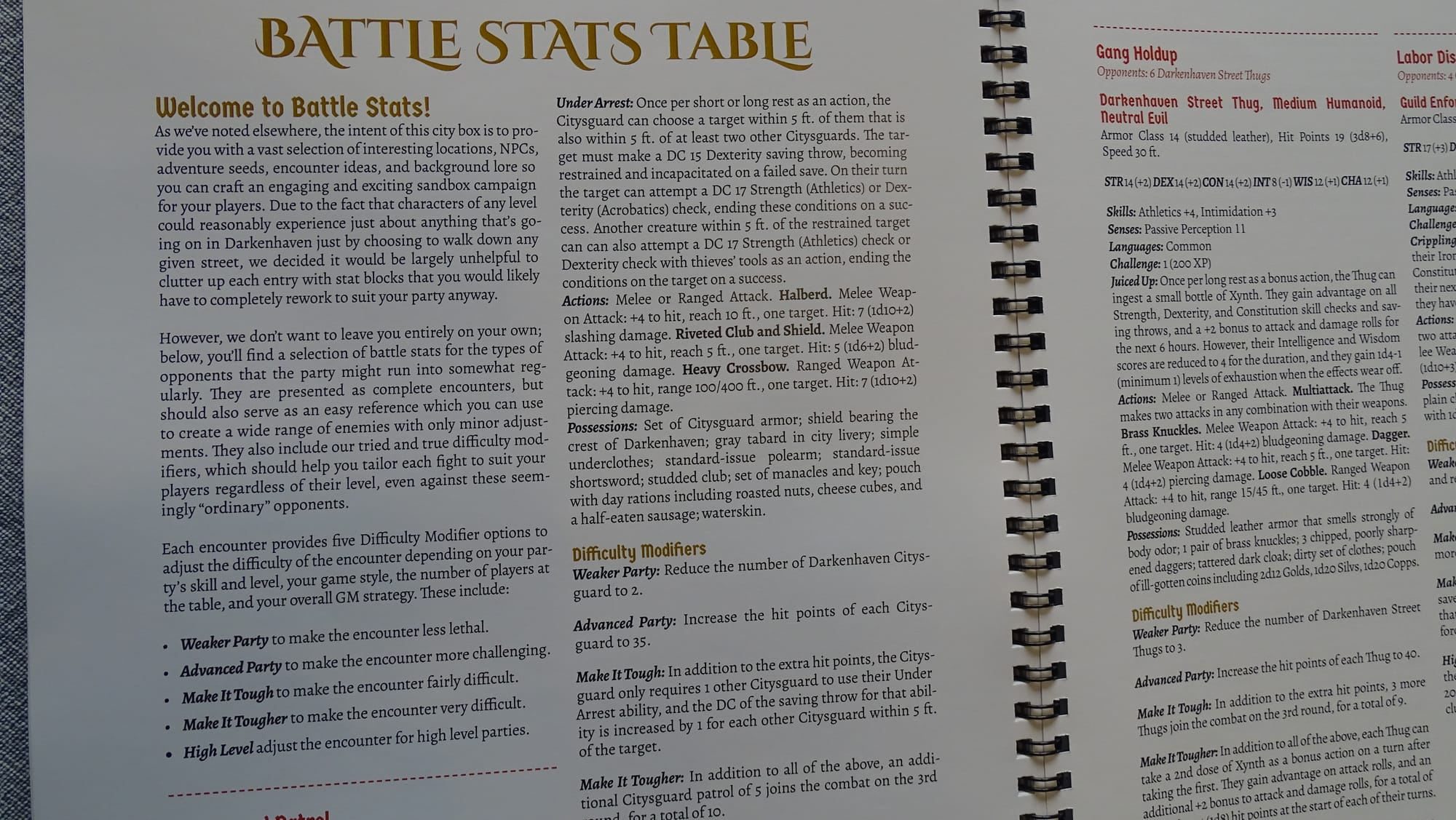
The rest of the book focuses on other aspects of running a game in the city. There are things like mundane treasure tables, name generation tables, charts on buying or renting properties and services, rumor tables, and more traditional random encounter tables. The items from the item cards get their full explanations here as well.
The final things in the box to cover are the NPC cheat sheets, the city guide, and the mini-adventure The Deepest Fear. The cheat sheets are for a quick look up of the bigger players around the city and what organization they’re with. If the NPC has an entry in one of the books, the sheet directs you there. The guide is an in-universe black and white tourist guide for the city, the kind of thing you might find at a hotel. It’s meant to be passed to the players and is exactly what you’d expect characters to pick up when first arriving in town. The Deepest Fear is aimed at characters level 6-9 and is probably good for 2-3 sessions of play. It comes with its own adventure handouts, item cards, NSREs, and battle stats. If it’s a glimpse into what Gooey Cube adventures contain, then I definitely want to see more.
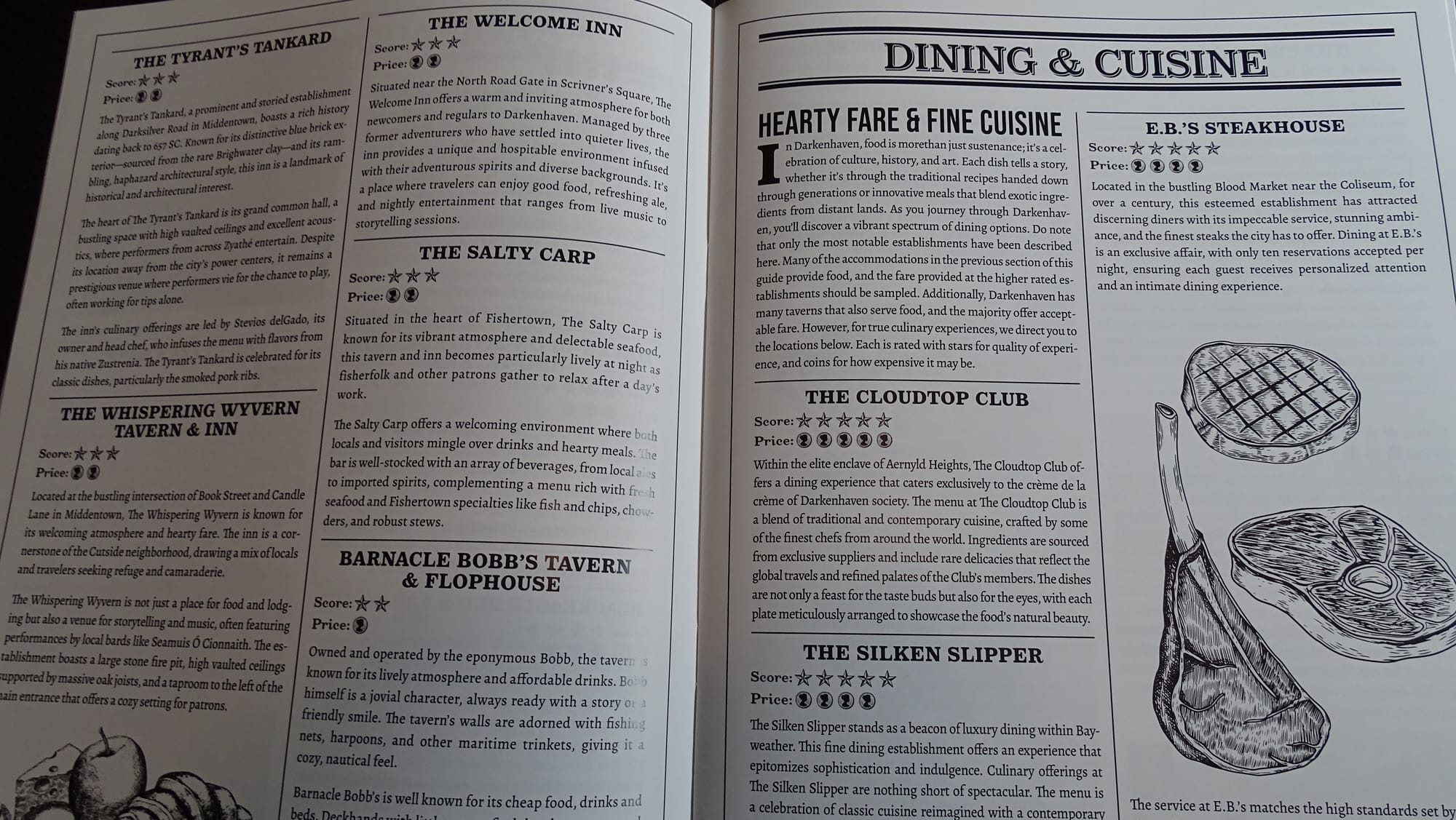
The last thing in the box set is the QR code for the digital versions of everything in the box. Yes, buying the physical product includes digital versions of all of it. Having the art and maps is nice and can be good for quick reference, especially the DM city maps. Having well indexed, searchable PDFs of the books though, that’s a different matter. Even though all the physical products are cross referenced, it’s hard to beat the speed of digital tools when you need them.
So, in case it’s not obvious, I’m a fan of what’s on offer here. But it’s not quite perfect, and not a good fit for everyone. The biggest caveat to note is that Darkenhaven is very tied in with the wider setting of Zyathé. This setting has quite a lot packed into it, in particular a ton of new races that don’t exist in any other setting. The books spend a lot of time talking about the Sarth, the Fay’aree, Flowstones, the Blood-Touched, and so much more, but basically no time explaining what those things are. Using Darkenhaven in a different setting wouldn’t be impossible, but doing so will put quite a lot of work on the gamemaster. Likely not as much as making a whole new city from scratch, but it is worth noting.
Also worth mentioning is that Gooey Cube has put up a free Zyathé Player’s Primer PDF on their store. This guide isn’t enough to actually make characters using those races and concepts, but it is enough to understand more of the setting without having to grab the full setting book. Still, it doesn’t cover everything that shows up in Darkenhaven. Despite reading the Firehouse section several times I’m not certain what Vyles and Rat-Folk are. I’m not even completely certain they’re different things. There’s also monsters that are mentioned or expected to be fought, like the catagator, but no stat block or description is presented despite getting its own art page. Of course, there is already so much here that it makes these few missing things stand out.
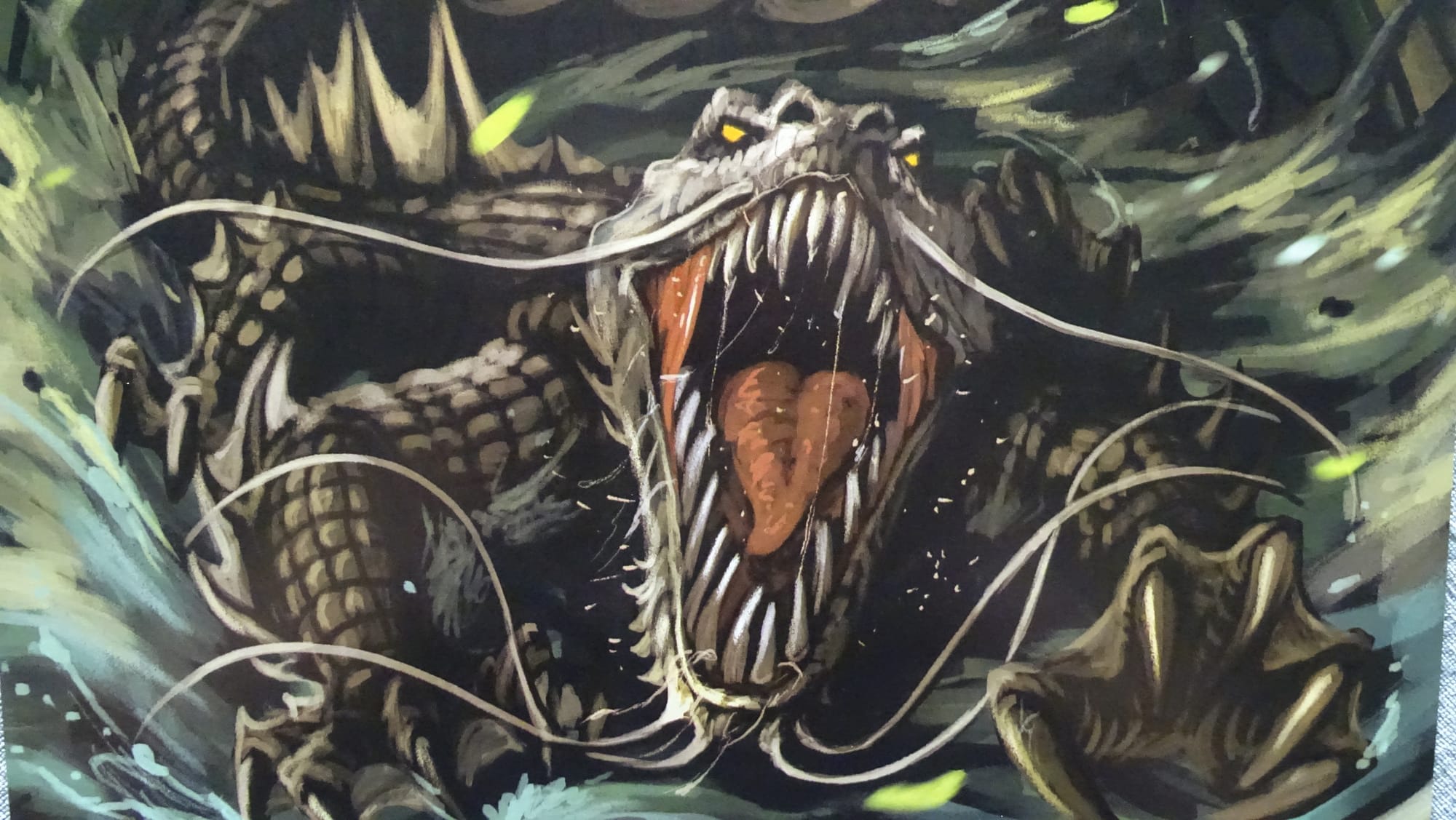
Those issues aside, this is an amazing product. With so much work put into the lore, and so much attention to detail in the various districts, Darkenhaven feels more real than any other RPG city I can think of. All of the groundwork has been laid, all that’s missing is the gamemaster and the players.
Darkenhaven
Excellent
A treasure trove of content, Darkenhaven is a fully realized urban setting. It’s got gorgeous art, epic maps, and a deep pool of lore to swim in, just be careful not to drown.
Pros
- A feast of visual material in the form of maps and artwork.
- Fleshed out districts with their own unique place in the city, ripe for exploration.
- A huge amount of lore and history give the GM everything they need to run the city.
Cons
- Deep ties to the Zyathé setting can cause confusion unless you have access to that setting information.
- Those same ties can make it difficult to use the city in a different setting.
This review is based on a retail copy provided by publisher.
